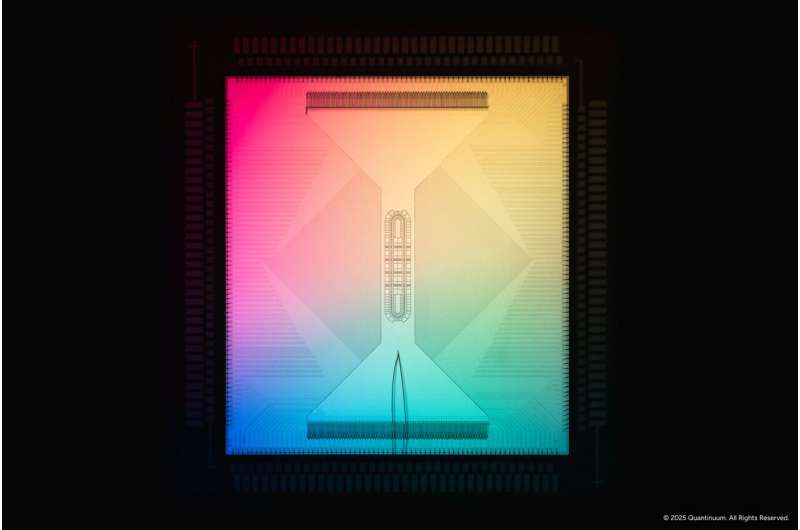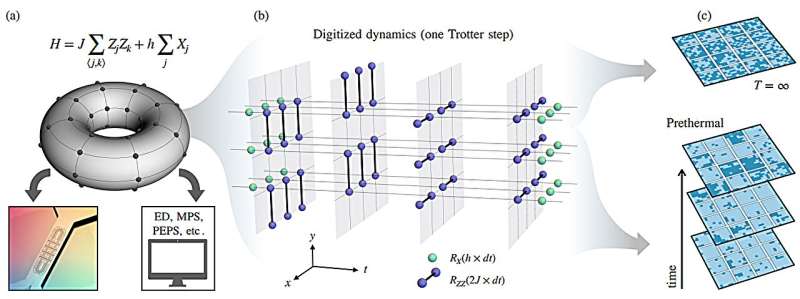Quantum computers, which process information leveraging quantum mechanical effects, have the potential to outperform classical computers in some optimization and computational tasks. In addition, they could be used to simulate complex quantum systems that cannot be simulated using classical computers.
Researchers at Quantinuum and other institutes in Europe and the United States recently set out to simulate the digitized dynamics of the quantum Ising model, a framework that describes quantum magnetism in materials, using an advanced quantum computer.
Their simulations, outlined in a paper on the arXiv preprint server, led to the observation of a transient state known as Floquet prethermalization, in which systems appear locally stable before approaching full equilibrium, in regimes that are inaccessible to classical computers.
“Simulating continuous time evolution on digital quantum computers has been a longstanding goal in the field of quantum computation, thus we are certainly not the first or only people wanting to do this,” Michael Foss-Feig, a researcher at Quantinuum and lead author of the paper, told Phys.org.
“However, achieving this at a scale that rivals or exceeds the best classical methods is much more challenging than achieving quantum advantage in more contrived scenarios, such as random-circuit-sampling, and had not yet been achieved.”
Last year, Foss-Feig and his colleagues at Quantinuum successfully used a quantum computer they developed to complete random circuit sampling tasks that could not be completed by classical computers, with unprecedented fidelities. This achievement inspired them to explore the potential of quantum computers for completing a wider range of problems.
“These early results, together with progress in our gate fidelities over the last year, convinced us to start thinking seriously about whether beyond-classical quantum simulation might be within reach,” explained Foss-Feig.
As part of their recent study, the researchers used H2, a quantum computer developed at Quantinuum, to simulate the dynamics of the quantum Ising model. The quantum Ising model is a standard model used to study magnetism, quantum phase transitions and emergent physics in complex systems.

“In real systems, time passes smoothly, and simulating realistic dynamics on a digital quantum computer requires ‘discretizing’ this smooth time evolution into the set of quantum gates that one has available,” said Foss-Feig. “Discretization is never perfect, but we did it well enough to observe many of the hallmark features of real physical systems.
“In particular, the smoothness of time is ultimately responsible for energy being conserved in real systems, which causes them to naturally relax to an equilibrium state after being pushed far out of equilibrium.”
The simulations run by Foss-Feig and his colleagues digitally reproduce continuous-time dynamics, thus showing how quantum systems evolve over time. In their simulations, the researchers observed characteristic signatures of these systems when they are approaching a state of equilibrium, such as the emergence of a hydrodynamic energy transport.
“The most important achievement of this work is that we were able to keep this continuous time-evolution relatively noise-free (and therefore accurate) out to timescales where even the best classical simulation methods appear to really struggle,” said Reza Haghshenas, a researcher at Quantinuum leading the classical benchmarking efforts.
“I say ‘struggle,’ and not ‘fail,’ because we believe that with substantial classical resources (i.e., running the best classical algorithms with super-computer scale resources) it may well be possible to perform comparably accurate simulations classically. However, we also believe this to be possible only because of the limited number of qubits (56) we used in these simulations.”

This recent study by Foss-Feig and his colleagues demonstrates the potential of quantum computers for the realistic simulation of complex quantum systems, which are difficult or impossible to simulate using classical computers. The researchers are now working on further advancing and upscaling quantum computers, which could further boost their ability to simulate quantum systems.
Their recent work shows that the current gate fidelities of the H2 quantum computer are already high enough to simulate physical systems in regimes that are difficult to access using classical computers. Future quantum computers based on even greater numbers of qubits could simulate even larger and more complex systems, which could in turn improve the understanding of their underlying physics.
“Moderate increases in system sizes (qubit numbers) should enable simulations that are more definitively out of reach of current classical methods, and we are very much looking forward to releasing our next system, Helios, with 96 qubits,” added Foss-Feig.
“We view this as an incredibly exciting point in time. Many important technologies have emerged from our (limited) ability to classically simulate quantum systems, and advances in simulation methods can have broad impacts: Quantum computers may soon be capable of validating and augmenting classical simulations in settings where classical methods are infeasible or unreliable.”
More information:
Reza Haghshenas et al, Digital quantum magnetism at the frontier of classical simulations, arXiv (2025). DOI: 10.48550/arxiv.2503.20870
© 2025 Science X Network
Citation:
Simulating quantum magnetism with a digital quantum computer (2025, April 10)
retrieved 10 April 2025
from
This document is subject to copyright. Apart from any fair dealing for the purpose of private study or research, no
part may be reproduced without the written permission. The content is provided for information purposes only.

